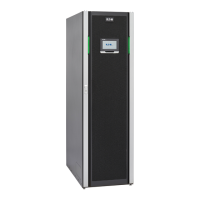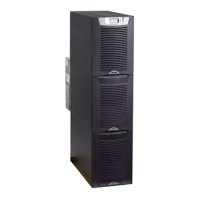11 Eaton® 9390 (100–160 kVA) UPS Installation and Operation Manual 164201604—Rev F
CChhaapptteerr 33 UUPPSS IInnssttaallllaattiioonn PPllaann aanndd UUnnppaacckkiinngg
Use the following basic sequence of steps to install the UPS:
1. Create an installation plan for the UPS system (see 3.1 Creating an Installation Plan).
2. Prepare your site for the UPS system (see 3.2 Preparing the Site).
3. Inspect and unpack the UPS cabinet (see 3.3 Inspecting and Unpacking the UPS Cabinet).
4. Unload and install the UPS cabinet and wire the system (see Chapter 4 Installing the UPS System).
5. Install features, accessories, or options, as applicable (see
Chapter 5 Installing a Remote Emergency Power-off Control and
Chapter 6 Installing Optional Accessories).
6. Complete the Installation Checklist (see Chapter 4 Installing the UPS System).
7. Have authorized service personnel perform preliminary operational checks and startup.
NNOOTTEE Startup and operational checks must be performed by an authorized Eaton Customer
Service Engineer, or the warranty terms specified in 1.8 Warranty become void. This
service is offered as part of the sales contract for the UPS. Contact your Eaton service
representative in advance (usually a two-week notice is required) to reserve a preferred
startup date.
33..11 CCrreeaattiinngg aann IInnssttaallllaattiioonn PPllaann
Before installing the UPS system, read and understand how this manual applies to the system being installed.
Use the procedures and illustrations in the following chapters to create a logical plan for installing the system.
33..22 PPrreeppaarriinngg tthhee SSiittee
For the UPS system to operate at peak efficiency, the installation site should meet the environmental
parameters outlined in this manual. If the UPS is to be operated at an altitude higher than 1500m (5000 ft),
contact your Eaton service representative for important information about high altitude operation. The operating
environment must meet the weight, clearance, and environmental requirements specified in Figure 80 and size
requirements specified in Figure 87.
The UPS cabinets use forced air cooling to regulate internal component temperature. Air inlets are in the front
of the cabinet and outlets are in the top. You must allow clearance in front of and above each cabinet for proper
air circulation.
33..22..11 EEnnvviirroonnmmeennttaall CCoonnssiiddeerraattiioonnss
The life of the UPS system is adversely affected if the installation does not meet the following guidelines:
• The system must be installed on a level floor suitable for computer or electronic equipment.
• The system must be installed in a temperature and humidity controlled indoor area free of conductive
contaminants.
Failure to follow guidelines may void your warranty.
33..22..22 PPrreeppaarriinngg ffoorr WWiirriinngg tthhee UUPPSS SSyysstteemm
NNOOTTEE If installing, as part of the UPS system, a maintenance bypass without a rectifier input
breaker, a minimum of two separate feeds with upstream feeder breakers, or one feed
with two upstream feeder breakers, must be provided: one for the UPS and one for the
maintenance bypass input. DO NOT use one feed or a single feeder breaker to supply
both the UPS and the maintenance bypass.
UPS Installation Plan and Unpacking

